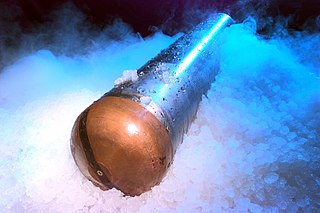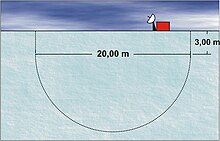
Lake Vostok is the largest of Antarctica's 675 known subglacial lakes. Lake Vostok is located at the southern Pole of Cold, beneath Russia's Vostok Station under the surface of the central East Antarctic Ice Sheet, which is at 3,488 m (11,444 ft) above mean sea level. The surface of this fresh water lake is approximately 4,000 m (13,100 ft) under the surface of the ice, which places it at approximately 500 m (1,600 ft) below sea level.

Enceladus is the sixth-largest moon of Saturn and the 18th-largest in the Solar System. It is about 500 kilometers in diameter, about a tenth of that of Saturn's largest moon, Titan. It is mostly covered by fresh, clean ice, making it one of the most reflective bodies of the Solar System. Consequently, its surface temperature at noon reaches only −198 °C, far colder than a light-absorbing body would be. Despite its small size, Enceladus has a wide variety of surface features, ranging from old, heavily cratered regions to young, tectonically deformed terrain.

Ablation is the removal or destruction of something from an object by vaporization, chipping, erosive processes, or by other means. Examples of ablative materials are described below, including spacecraft material for ascent and atmospheric reentry, ice and snow in glaciology, biological tissues in medicine and passive fire protection materials.

A jökulhlaup is a type of glacial outburst flood. It is an Icelandic term that has been adopted in glaciological terminology in many languages. It originally referred to the well-known subglacial outburst floods from Vatnajökull, Iceland, which are triggered by geothermal heating and occasionally by a volcanic subglacial eruption, but it is now used to describe any large and abrupt release of water from a subglacial or proglacial lake/reservoir.

A subglacial lake is a lake that is found under a glacier, typically beneath an ice cap or ice sheet. Subglacial lakes form at the boundary between ice and the underlying bedrock, where liquid water can exist above the lower melting point of ice under high pressure. Over time, the overlying ice gradually melts at a rate of a few millimeters per year. Meltwater flows from regions of high to low hydraulic pressure under the ice and pools, creating a body of liquid water that can be isolated from the external environment for millions of years.
Lake Ellsworth is a natural freshwater liquid subglacial lake located in West Antarctica under approximately 2.93–3.28 km (1.82–2.04 mi) of ice. It is approximately 14.7 km (9.1 mi) long and is estimated to be 156 m (512 ft) in max. depth. The lake is named after the American explorer Lincoln Ellsworth. The surface of the lake itself is located, approximately 3,379–4,528 feet (1,030–1,380 m) below mean sea level. Elevation of icecap covering, the lake: 1,900–1,925 m (6,234–6,316 ft) m.a.s.l.

A cryobot or Philberth-probe is a robot that can penetrate water ice. A cryobot uses heat to melt the ice, and gravity to sink downward.

The exploration of Saturn has been solely performed by crewless probes. Three missions were flybys, which formed an extended foundation of knowledge about the system. The Cassini–Huygens spacecraft, launched in 1997, was in orbit from 2004 to 2017.

Blood Falls is an outflow of an iron(III) oxide–tainted plume of saltwater, flowing from the tongue of Taylor Glacier onto the ice-covered surface of West Lake Bonney in the Taylor Valley of the McMurdo Dry Valleys in Victoria Land, East Antarctica.
Stone Aerospace is an aerospace engineering firm founded by engineer and explorer Bill Stone, located in Del Valle, a suburb of Austin, Texas.
Jane K. Hart is a Professor of Physical Geography in the School of Geography and Environmental Science at the University of Southampton UK. She has a BSc in Physical Geography from the University of Reading and a PhD in Glaciology from the University of East Anglia. She was Lecturer in Physical Geography at the University of Manchester (1988–89). Currently, she is EGU General Secretary, President of the Quaternary Research Association (QRA) and Chair of the "Funds for Women Graduates".
Enceladus Explorer (EnEx) is a planned interplanetary orbiter and lander mission equipped with a subsurface maneuverable ice melting probe suitable to assess the existence of life on Saturn's moon Enceladus.
Mars habitability analogue environments on Earth are environments that share potentially relevant astrobiological conditions with Mars. These include sites that are analogues of potential subsurface habitats, and deep subsurface habitats.

Ice drilling allows scientists studying glaciers and ice sheets to gain access to what is beneath the ice, to take measurements along the interior of the ice, and to retrieve samples. Instruments can be placed in the drilled holes to record temperature, pressure, speed, direction of movement, and for other scientific research, such as neutrino detection.
Martin J. Siegert is a British glaciologist, and Deputy Vice Chancellor (Cornwall) at the University of Exeter. He co-Chairs the Diversity in Polar Science Initiative, and has spoken about socio-economic inclusion in Polar Science and indeed broader society.
Scientific ice drilling began in 1840, when Louis Agassiz attempted to drill through the Unteraargletscher in the Alps. Rotary drills were first used to drill in ice in the 1890s, and thermal drilling, with a heated drillhead, began to be used in the 1940s. Ice coring began in the 1950s, with the International Geophysical Year at the end of the decade bringing increased ice drilling activity. In 1966, the Greenland ice sheet was penetrated for the first time with a 1,388 m hole reaching bedrock, using a combination of thermal and electromechanical drilling. Major projects over the following decades brought cores from deep holes in the Greenland and Antarctic ice sheets.

SPINDLE is a 2-stage autonomous vehicle system consisting of a robotic ice-penetrating carrier vehicle (cryobot) and an autonomous submersible HAUV . The cryobot is designed to descend through an ice body into a sub-surface ocean and deploy the HAUV submersible to conduct long range reconnaissance, life search, and sample collection. The HAUV submersible will return to, and auto-dock with, the cryobot at the conclusion of the mission for subsequent data uplink and sample return to the surface.
The World Is Not Enough (WINE) is a US project developing a refuelable steam engine system for spacecraft propulsion. WINE developed a method of extracting volatiles from ice, ice-rich regolith, and hydrated soils and uses it as steam propulsion which allows the spacecraft to refuel multiple times and have an extraordinary long service lifetime. This would allow a single spacecraft to visit multiple asteroids, comets or several landing locations at an icy world such as the Moon, Mars, Pluto, Enceladus, Ganymede, Europa, etc.

BRUIE is an autonomous underwater vehicle prototype by NASA's Jet Propulsion Laboratory. The prototype began underwater testing in 2012 and it is meant to eventually explore the interior of water worlds in the Solar System, such as Europa or Enceladus.

Igor Alekseevich Zotikov was a Russian glaciologist, polar explorer and academic. Zotikov was best known for predicting the existence of fresh water lakes under the Antarctic ice sheet, later to be discovered as Lake Vostok. For his efforts a glacier was named after him, Zotikov Glacier.


















